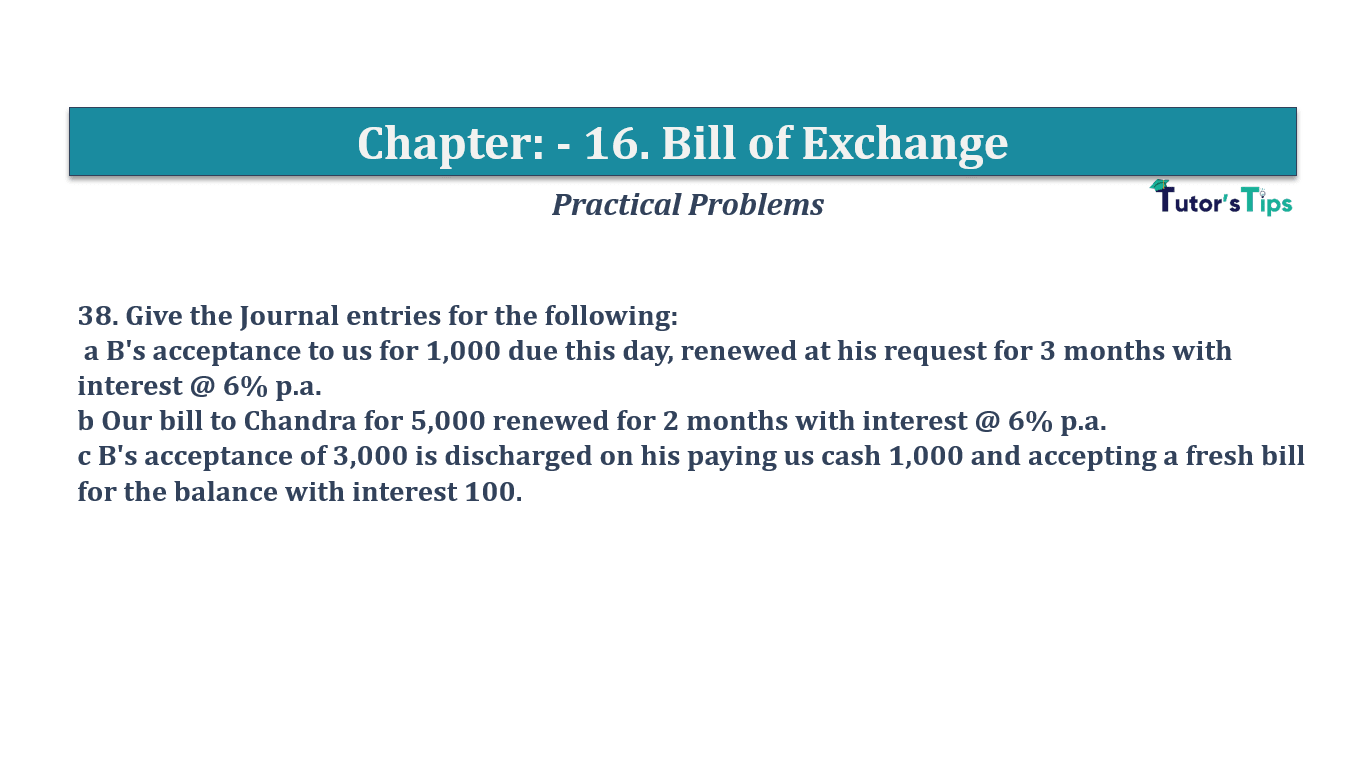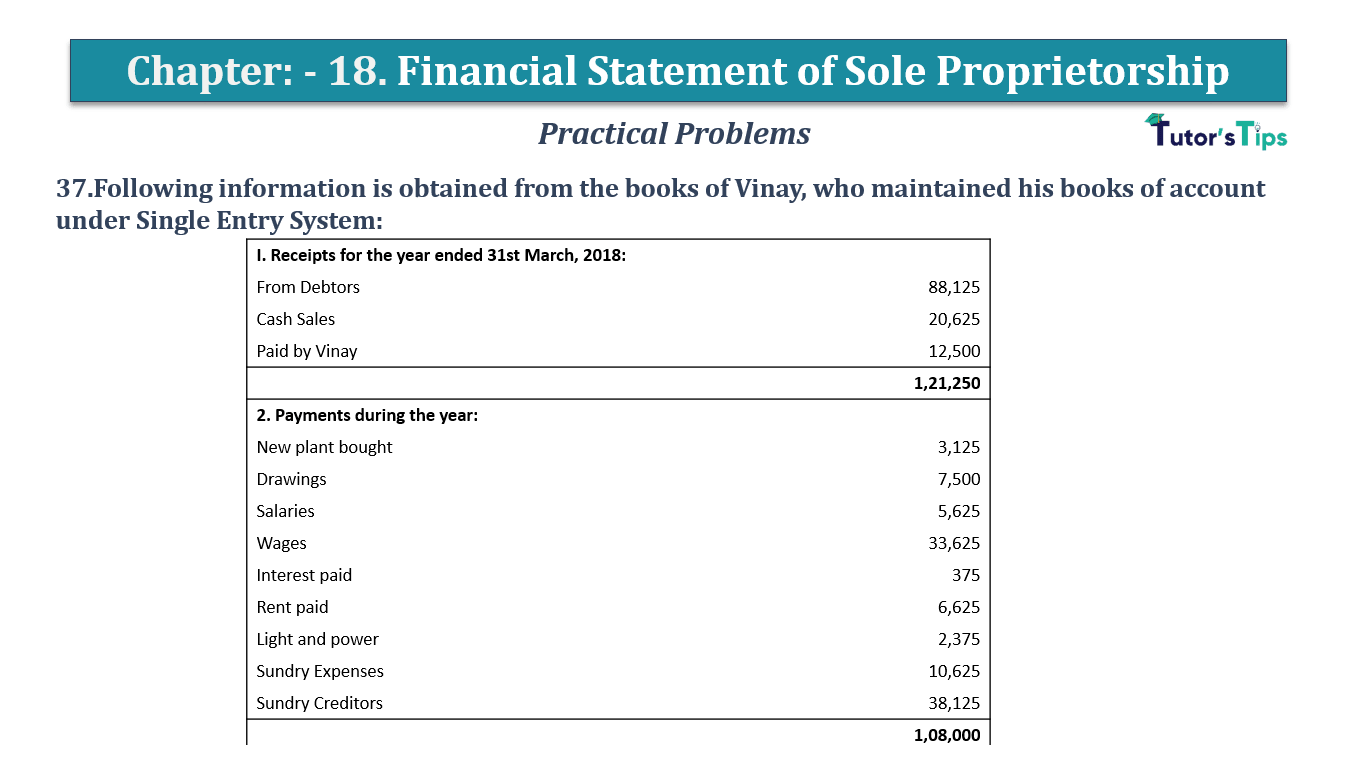Advertisement
Question No 34 Chapter No 19
Advertisement
34. From the following information, ascertain the opening balance of Sundry Debtors and the closing balance of Sundry Creditors
| Sundry Creditors as on 31st March, 2017 | 20,600 |
| Sundry Debtors as on 31st March, 2018 | 37,400 |
| Stock as on 31st March, 2017 | 26,000 |
| Stock as on 31st March, 2018 | 24,000 |
| During the year ended 31st March, 2018: | |
| Purchases | 1,10,000 |
| Discount allowed by creditors | 800 |
| Discount allowed to customers | 1,100 |
| Cash paid to sundry creditors | 95,000 |
| Bills Payable issued by them | 14,000 |
| Bills Receivable received from customers | 16,500 |
| Cash received from customers | 1,30,000 |
| Bills receivable dishonored | 1,900 |
The solution of Question No 34 Chapter No 19:-
Advertisement-X
| Debtors Account | |||||
| Liabilities | Amount | Assets | Amount | ||
| Balance b/d | 43,100 | Cash A/c | 1,30,000 | ||
| Sales A/c | 1,40,000 | Discount Allowed A/c | 1,100 | ||
| Bill Receivable A/c | 1,900 | Bill Receivable A/c | 16,500 | ||
| Balance c/d | 37,400 | ||||
| 1,85,000 | 1,85,000 | ||||
| Creditors Account | |||||
| Liabilities | Amount | Assets | Amount | ||
| Cash A/c | 43,100 | Balance b/d | 20,600 | ||
| Discount Received A/c | 1,40,000 | Purchases A/c | 1,10,000 | ||
| Bills Payable A/c | 1,900 | ||||
| Balance c/d | 20,800 | ||||
| 1,30,600 | 1,30,600 | ||||
| Cost of Goods Sold | = | Opening Stock + Purchases – Closing Stock |
| Cost of Goods Sold | = | 26,000 + 1,10,000 – 24,000 |
| = | 1,12,000 |
| Gross Profit | = | 1,12,000 | X | 30 |
| 70 | ||||
| = | 48,000 |
| Sale | = | Cost of Goods Sold + Gross Profit |
| Sale | = | 1,12,000 + 48,000 |
| = | 1,60,000 | |
| Credit Sales | = | 1,60,000 – 20,000 |
| = | 1,40,000 |
Final Accounts: Meaning, Definition and Explanation
Profit and Loss Account: Meaning, Format & Examples
Advertisement-X
Advertisement-Y
Balance Sheet: Meaning, Format & Examples
Thanks, Please Like and share with your friends
Comment if you have any question.
Also, Check out the solved question of previous Chapters: –
- Chapter No. 1 – Introduction to Accounting
- Chapter No. 2 – Basic Accounting Terms
- Chapter No. 3 – Theory Base of Accounting, Accounting Standards and International Financial Reporting Standards(IFRS)
- Chapter No. 4 – Bases of Accounting
- Chapter No. 5 – Accounting Equation
- Chapter No. 6 – Accounting Procedures – Rules of Debit and Credit
- Goods and Services Tax(GST)
- Chapter No. 7 – Origin of Transactions – Source Documents and Preparation of Vouchers
- Chapter No. 8 – Journal
- Chapter No. 9 – Ledger
- Chapter No. 10 – Special Purpose Books I – Cash Book
- Chapter No. 11 – Special Purpose Books II – Other Books
- Chapter No. 12 – Bank Reconciliation Statement
- Chapter No. 13 – Trial Balance
- Chapter No. 14 – Depreciation
- Chapter No. 15 – Provisions and Reserves
- Chapter No. 16 – Accounting for Bills of Exchange
- Chapter No. 17 – Rectification of Errors
- Chapter No. 18 – Financial Statements of Sole Proprietorship
- Chapter No. 19 – Adjustments in preparation of Financial Statements
- Chapter No. 20 – Accounts from incomplete Records – Single Entry System
- Chapter No. 21 – Computers in Accounting
- Chapter No. 22 – Accounting Software – Tally
- Chapter No. 5 – Accounting Equation
- Chapter No. 6 – Accounting Procedures – Rules of Debit and Credit
- Goods and Services Tax(GST)
- Chapter No. 8 – Journal
- Chapter No. 9 – Ledger
- Chapter No. 10 – Special Purpose Books I – Cash Book
Check out T.S. Grewal +1 Book 2019 @ Official Website of Sultan Chand Publication












1 Comment